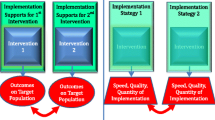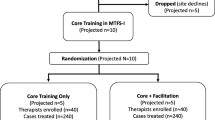Abstract
System dynamics (SD) modeling is used to compare and contrast strategies for effective implementation of an evidence-based adolescent behavioral health treatment in primary care settings. With qualitative and quantitative data from an on-going cluster-randomized trial in 7 federally qualified health center sites, two implementation conditions were compared: generalist vs. specialist. In the generalist approach, the primary care provider (PCP) delivered brief intervention (BI) for substance misuse (n = 4 clinics). In the specialist approach, BIs were delivered by behavioral health counselors (BHCs) (n = 3 clinics). The resultant SD model compared ‘basecase’ dynamics to strategic approaches to deploying continuous technical assistance (TA) and performance feedback reporting (PFR). The basecase effectively represented the SBIRT intervention, which reflected actual monthly volume of adolescent primary care visits (N = 9639), screenings (N = 5937), positive screenings (N = 246), and brief interventions (BIs; N = 50) over the 20-month implementation period. Insights gained suggest that implementation outcomes are sensitive to frequency of PFR, with bimonthly events generating the most rapid and sustained screening results. Simulated trends indicated that availability of the BHC directly impacts success of the specialist model. Similarly, understanding PCPs’ perception of severity of need for intervention is key to outcomes in either condition.






Similar content being viewed by others
References
Johnston LD, Miech RA, O’Malley PM, et al. Monitoring the Future National Survey Results on Drug Use: 1975–2017: Overview, Key Findings on Adolescent Drug Use. Ann Arbor: Institute for Social Research, The University of Michigan, 2018, pp. 116.
Knight JR, Sherritt L, Harris SK, et al. Validity of Brief Alcohol Screening Tests Among Adolescents: A Comparison of the AUDIT, POSIT, CAGE, and CRAFFT. Alcoholism, Clinical and Experimental Research. 2003;27(1):67–73.
Knight JR, Sherritt L, Shrier LA, et al. Validity of the CRAFFT Substance Abuse Screening Test Among Adolescent Clinic Patients. Archives of Pediatrics and Adolescent Medicine. 2002;156(6):607–614.
Reinert DF, Allen JP. The Alcohol Use Disorders Identification Test: An Update of Research Findings. Alcoholism, Clinical and Experimental Research. 2007;31(2):185–199.
D'Amico EJ, Miles JN, Stern SA, et al. Brief Motivational Interviewing for Teens at Risk of Substance Use Consequences: A Randomized Pilot Study in a Primary Care Clinic. Journal of Substance Abuse Treatment. 2008;35(1):53–61.
Kaner EFS, Dickinson HO, Beyer F, et al. Effectiveness of Brief Alcohol Interventions in Primary Care Populations. Cochrane Database of Systematic Reviews 2007, Issue 2, 2007.
Millstein SG, Marcell AV. Screening and Counseling for Adolescent Alcohol Use Among Primary Care Physicians in the United States. Pediatrics. 2003;111(1):114–122.
Winters KC, Leitten W. Brief Intervention for Drug-Abusing Adolescents in a School Setting. Psychology of Addictive Behaviors. 2007;21(2):249–254.
Winters KC, Leitten W, Wagner E, et al. Use of Brief Interventions for Drug Abusing Teenagers Within a Middle and High School Setting. Journal of School Health. 2007;77(4):196–206.
Bernstein E, Edwards E, Dorfman D, et al. Screening and Brief Intervention to Reduce Marijuana Use Among Youth and Young Adults in a Pediatric Emergency Department. Academic Emergency Medicine. 2009;16(11):1174–1185.
Gryczynski J, Mitchell SG, Peterson TR, et al. The relationship between services delivered and substance use outcomes in New Mexico's Screening, Brief Intervention, Referral and Treatment (SBIRT) Initiative. Drug and Alcohol Dependence. 2011;118(2–3):152–157.
Krupski A, Sears JM, Joesch JM, et al. Impact of Brief Interventions and Brief Treatment on Admissions to Chemical Dependency Treatment. Drug and Alcohol Dependence. 2010;110(1–2):126–136.
Madras BK, Compton WM, Avula D, et al. Screening, Brief Interventions, Referral to Treatment (SBIRT) for Illicit Drug and Alcohol Use at Multiple Healthcare Sites: Comparison at Intake and 6 Months Later. Drug and Alcohol Dependence. 2009;99(1–3):280–295.
Martin G, Copeland J. The Adolescent Cannabis Check-Up: Randomized Trial of a Brief Intervention for Young Cannabis Users. Journal of Substance Abuse Treatment. 2008;34(4):407–414.
McCambridge J, Strang J. The Efficacy of Single-Session Motivational Interviewing in Reducing Drug Consumption and Perceptions of Drug-Related Risk and Harm Among Young People: Results from a Multi-Site Cluster Randomized Trial. Addiction. 2004;99(1):39–52.
Peterson PL, Baer JS, Wells EA, et al. Short-Term Effects of a Brief Motivational Intervention to Reduce Alcohol and Drug Risk Among Homeless Adolescents. Psychology of Addictive Behaviors. 2006;20(3):254–264.
Tait RJ, Hulse GK, Robertson SI. Effectiveness of a Brief-Intervention and Continuity of Care in Enhancing Attendance for Treatment by Adolescent Substance Users. Drug and Alcohol Dependence. 2004;74(3):289–296.
Tait RJ, Hulse GK. A Systematic Review of the Effectiveness of Brief Interventions with Substance Using Adolescents by Type of Drug. Drug and Alcohol Review. 2003;22(3):337–346.
Tripodi SJ, Bender K, Litschge C, et al. Interventions for Reducing Adolescent Alcohol Abuse: A Meta-Analytic Review. Archives of Pediatrics and Adolescent Medicine. 2010;164(1):85–91.
Porter ME, Lee TH. From Volume to Value in Health Care: The Work Begins. The Journal of American Medicial Association. 2016;316(10):1047–1048.
Proctor E, Silmere H, Raghavan R, et al. Outcomes for Implementation Research: Conceptual Distinctions, Measurement Challenges, and Research Agenda. Administration and Policy in Mental Health. 2011;38(2):65–76.
Gonzalo JD, Starr SR, Borkan JM. What is Health Systems Science? Building an Integrated Vision. In Skochelak SE, Hawkins RE, Lawson LE, et al., (Eds). Health Systems Science. AMA: Elsevier, 2016;10–23.
Zimmerman L, Lounsbury DW, Rosen CS, et al. Participatory System Dynamics Modeling: Increasing Stakeholder Engagement and Precision to Improve Implementation Planning in Systems. Administration and Policy in Mental Health. 2016;43(6):834–849.
Manni KE, Cavana RY. Systems Thinking and Modelling. Cambridge, MA: Pegasus Publications, 2000.
Richardson GP, Pugh III AL. Introduction to System Dynamics Modeling. Portland, Oregon: Productivity Press, 1981.
Burke JG, Lich KH, Neal JW, et al. Enhancing Dissemination and Implementation Research Using Systems Science Methods. International Journal of Behavioral Medicine. 2015;22(3):283–291.
Holmes BJ, Finegood DT, Riley BL, et al. Systems Thinking in Dissemination and Implementation Research. In Brownson CaP, (Ed). Dissemination and Implementation Research in Health: Translating Science to Practice, 2012;143–156.
Forrester JW. Principles of Systems. Cambridge: Wright-Allen Press, 1971.
Forrester JW. Policies, Decisions, and Information Sources for Modeling. European Journal of Operational Research. 1992;59(1):42–63.
Forrester JW. System Dynamics, Systems Thinking, and Soft OR. System Dynamics Review. 1994;10(2–3):245–256.
Richardson GP. Feedback Thought in Social Science and Systems Theory. Waltham, MA: Pegasus Communications, Inc., 1991.
Roberts N, Anderson D, Deal R, et al. Introducation to Computer Simulation: A System Dynamics Modeling Approach. Reading, Massachusetts: Addison-Wiley Publishing Company, 1983.
Wolstenholme EF. System Dynamics: A System Methodology or a System Modelling Technique. Dynamica. 1983;9(II):84–90.
Mabry PL. Making Sense of the Data Explosion: The Promise of Systems Science. American Journal of Preventive Medicine. 2011;40(5 Suppl 2):S159–161.
Mabry PL, Kaplan RM. Systems Science: A Good Investment for the Public’s Health. Health Education and Behavior. 2013;40(1 Suppl):9s–12s.
Maglio PP, Sepulveda MJ, Mabry PL. Mainstreaming Modeling and Simulation to Accelerate Public Health Innovation. American Journal of Public Health. 2014;104(7):1181–1186.
Mitchell SG, Schwartz RP, Kirk AS, et al. SBIRT Implementation for Adolescents in Urban Federally Qualified Health Centers. Journal of Substance Abuse Treatment. 2016;60:81–90.
Proctor EK, Landsverk J, Aarons G, et al. Implementation Research in Mental Health Services: An Emerging Science with Conceptual, Methodological, and Training Challenges. Administration and Policy in Mental Health. 2009;36(1):24–34.
Forrester JW, Senge PM. Tests for Building Confidence in System Dynamics Models. TIMS Studies in the Management System. 1980;14:201–228.
Ventana Systems I. Vensim: Simulator for Business Open Education Resources, 2008.
Hovmand PS, Gillespie DF. Implementation of Evidence-Based Practice and Organzational Performance. Journal of Behavioral Health Services & Research. 2010;27(1):79–94.
Luna-Reyes LF, Martinez-Moyano IJ, Pardo TA, et al. Anatomy of a Group Model-Building Intervention: Building Dynamic Theory from Case Study Research. System Dynamics Review. 2006;22(4):291–320.
Oliva R. Model Calibration as a Testing Strategy for System Dynamics Models. European Journal of Operational Research. 2003;151:522–568.
Lich KH, Ginexi EM, Osgood ND, et al. A Call to Address Complexity in Prevention Science Research. Prevention Science. 2013;14(3):279–289.
Mabry PL, Olster DH, Morgan GD, et al. Interdisciplinarity and Systems Science to Improve Population Health: A View from the NIH Office of Behavioral and Social Sciences Research. American Journal of Preventive Medicine. 2008;35(2 Suppl):S211–224.
Rapkin BD, Weiss E, Lounsbury D, et al. Reducing Disparities in Cancer Screening and Prevention through Community-Based Participatory Research Partnerships with Local Libraries: A Comprehensive Dynamic Trial. American Journal of Community Psychology. 2017;60(1–2):145–159.
Weeks MR, Li J, Lounsbury D, et al. Using Participatory System Dynamics Modeling to Examine the Local HIV Test and Treatment Care Continuum in Order to Reduce Community Viral Load. American Journal of Community Psychology. 2017;60(3–4):584–598.
Levins R. A Strategy of Model Building in Population Biology. American Scientist. 1966;54(4):421–431.
Ip EH, Rahmandad H, Shoham DA, et al. Reconciling Statistical and Systems Science Approaches to Public Health. Health Education & Behavior. 2013;40(1 Suppl):123s–131s.
Acknowledgments
We thank Ms. Faye Royale-Larkins and the staff of Total Health Care for their collaboration on this project. We also thank Ms. Tinika Christopher for her help with manuscript preparations and Drs. Tisha Wiley and Lori Ducharme for their continued guidance in this work.
Author information
Authors and Affiliations
Corresponding author
Ethics declarations
Conflict of Interest
No financial disclosures were reported by the authors. Dr. Kirk was Vice President of Medical Affairs and a practicing pediatrician for the participating health center. Mrs. Oros and Ms. Hosler were from Mosaic Group, which provided technical assistance for the project.
Financial Support
National Institute on Drug Abuse grant 1R01DA034258-04.
Additional information
Publisher’s Note
Springer Nature remains neutral with regard to jurisdictional claims in published maps and institutional affiliations.
Rights and permissions
About this article
Cite this article
Lounsbury, D.W., Mitchell, S.G., Dusek, K.A. et al. Application of System Dynamics to Inform a Model of Adolescent SBIRT Implementation in Primary Care Settings. J Behav Health Serv Res 47, 230–244 (2020). https://doi.org/10.1007/s11414-019-09650-y
Published:
Issue Date:
DOI: https://doi.org/10.1007/s11414-019-09650-y




